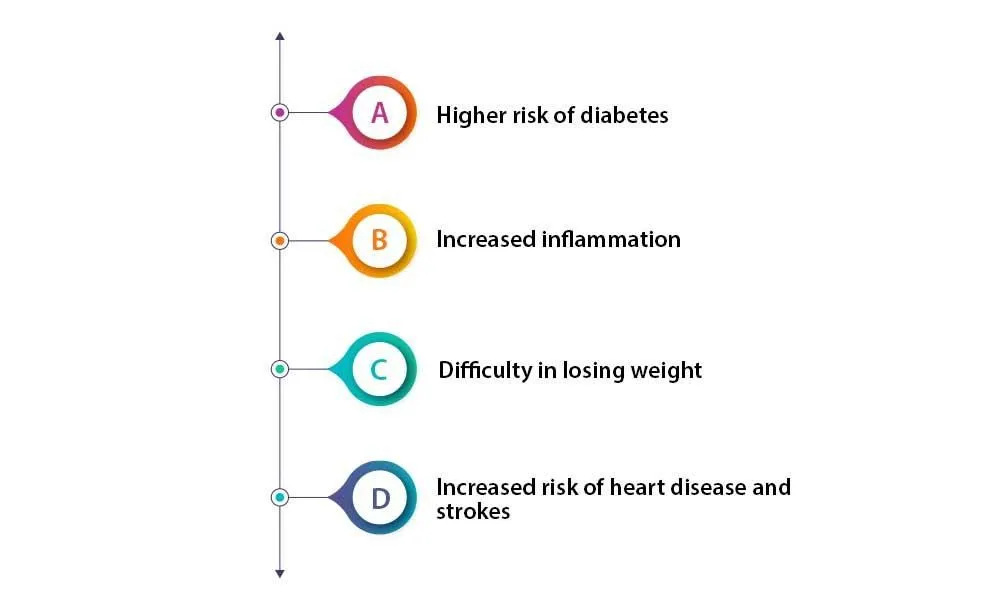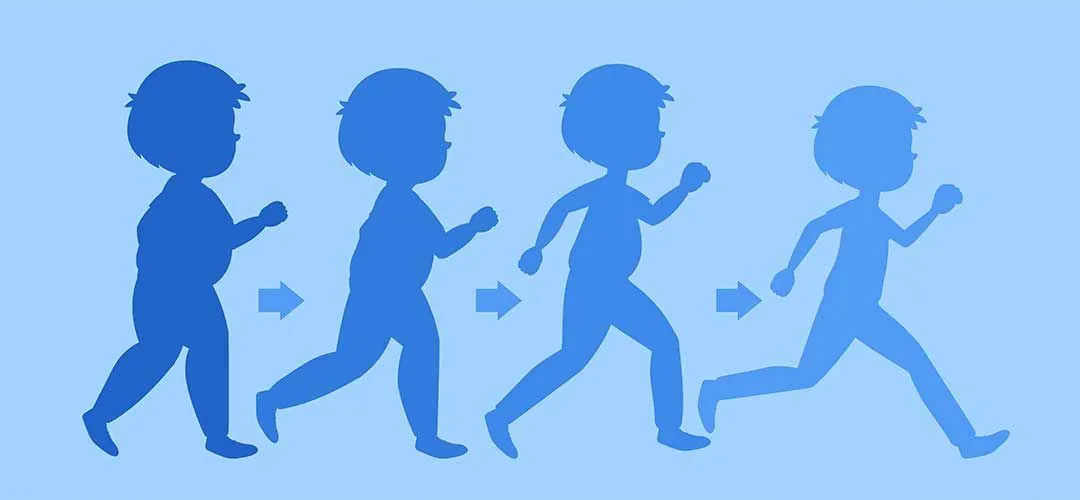Visceral fat (also called organ fat or intra-abdominal fat) is the accumulation of intra-abdominal adipose tissue. It is stored in the abdomen region and therefore covers several sensitive internal organs like the liver, pancreas, and intestines. This gel-type fat is stored under a layer of superficial belly fat and can cause your abdominal region to swell up, a sight usually called potbelly.
As an unwanted form of accumulated fat, it is known to cause metabolic disturbances and increase the risk for cardiovascular diseases and type 2 diabetes. It is worse in women and can even lead to the formation of lumps in the breast and gallbladder. Diabetics are also at a risk.
As mentioned above, visceral fat occurs as a layer of flab between the abdominal organs and in body cells called the Omentum. This is different from the subcutaneous fat that is only found between the skin and the outer abdominal skin.
Visceral fat is worse because it acts as an extra organ in the body and starts pumping out hormones and inflammatory substances. It may increase the production of unwanted chemicals, and control our mood, weight, eating patterns, digestion, and even the functioning of our brain.
A healthcare expert may measure visceral fat using Waist Measurement, Dual Energy X-Ray Absorptiometry (DEXA), and Professional Bioelectrical Impedance Analysis (BIA)
However, the most effective and certain way is to undergo a Magnetic Resonance Imaging (or MRI) scan. This process may additionally use a Body Composition Analyzer machine to assess the level of visceral fat in your body.
Around 10% of the total fat is likely to be stored as organ fat or intra-abdominal fat, therefore if you are carrying higher amounts of body fat, it is more likely that you are also storing excess body fat. We are next discussing what the risks of this dangerous fat type are and how you can avoid it.
Here’s a sample visceral body fat chart:
Gender / Body Fat |
Male |
Female |
Low Body Fat Risk |
Under 5% |
Under 15% |
Ultra-Lean |
5%-8% |
15-18% |
Lean |
8%-12% |
18-22% |
Moderately Lean |
12%-20% |
22-30% |
Excess Fat |
20%-30% |
30-40% |
High Body Fat Risk |
Above 30% |
Above 40% |
It is important to note the range that your body weight and body fat ratio relate to. You should quote this number to your healthcare service provider when you visit him. This would help him make a better and more personalized care plan for you.
Insulin and blood sugar directly affect our metabolic system. The human body breaks down sugar into simpler units of glucose to digest the food. These units then enter our bloodstream and trigger insulin in the pancreas and send some blood sugar into the cells in our body. This ultimately helps in energizing the brain and body tissues and increasing muscular functions.
Too much glucose turns into fat and can cause diabetes or heart-related issues. The longer these insulin levels spike, the more they turn into body fat and lead to weight gain. Consulting a professional dietitian or nutritionist could help you sort out your eating habits (here’s a link to help you with some smart tips about eating before that).
A potbelly is the surest indication of several types of illnesses and health issues in our body. It usually results from living a sedentary lifestyle and indulging in bad eating and drinking habits. Even if you feel comfortable with your current lifestyle today, you could still be at risk of several health issues later in your life.
Here is how excessive fat on your abdominal region can hurt you:
Abdominal fat plays a larger role in insulin resistance than other fats. This is the reason why any type of fat on the midsection is often considered worse than that on the hip or thigh. The same is true for diabetes and many other chronic diseases too.
Caution: Be sure to stay away from these most popular foods because they come laden with sugar!
Hormonal and inflammatory wastes are often dumped in the liver, thus leading to more inflammation and hormonal imbalances. If there is a layer of fat on the most crucial organs like the liver, heart, kidneys, pancreas, and intestines, it could slow down your metabolism drastically and make the situation life-threatening. Consuming alcohol would only make it worse.
Emotional eaters tend to gain weight as time passes on. One of the main reasons for it is that stored body fat affects their hunger and satiation levels. If you are obese, your metabolism rate would be slower than most people and once the temptation takes over, we overeat.
Inflammation caused by excessive fat is the main contributor to heart disease and other inflammatory disorders. Visceral fat is associated with an increased risk for cardiovascular disease markers like high triglycerides, high blood pressure, and high cholesterol.
Technically, it is hard to break out of a habit. However, it is not impossible to get rid of excess intra-abdominal fat and to enjoy better health. The key is to stay positive and to follow an expert’s advice about making systematic and calculated changes to your lifestyle.
We recommend consulting a fitness trainer and a nutritionist about how you may deal with the process. They would be best placed to create a personalized plan of action for you. Should you stay on it, you would become fitter and better.
Create and follow a meal plan that focuses on improving your health and weight management. As per our dietitians, you should limit your total daily fat intake to less than 30% and saturated fat to less than 70% of your total calories. You should also eliminate harmful trans-fats from the meals.
You can eat fresh vegetables and fruits, lean protein, and complex carbohydrates such as beans, lentils, and sprouted grains for energy and fiber. Cooking oils made of coconut, sunflower, olive, avocado, and grapeseed will also help. Remember that gluttony will not take you anywhere!
Note: Following the Mediterranean diet for a few months can deliver very good results in such cases.
It’s not just healthy eating, but overall lifestyle habits that play a crucial role in getting rid of a potbelly. You must stay away from smoking, drinking, junk foods, and refined carbs. Choosing healthier lifestyle choices will improve your quality of life and will show up in weight loss.
It’s not just healthy eating, but overall lifestyle habits that play a crucial role in getting rid of a potbelly. You must stay away from smoking, drinking, junk foods, and refined carbs. Choosing healthier lifestyle choices will improve your quality of life and will show up in weight loss.
It is important to exercise for at least 30 mins every day to stay fit and strong. If you lose around 5 to 10% of your total body weight, it can help in reducing the excess flab on your body. You should aim to burn more calories than you consume and for that, exercising is a must. Any form of exercise is welcomed-be it walking, circuit training, brisk walking, biking, or suchlike.
Don’t glaze your eyes over the menu. A double chocolate cheesecake has the same number of calories when at home and when traveling. It’s time to grip your temptations and apply the same healthy rules you follow at home. Look out for some healthy and simple dishes, prefer green salads!
Aerated drinks like cola and soft drinks contain calories and sugar. While they do taste good, they also slow down our metabolism and thus increase our chances to put on some flab. This is especially true for people whose parents are obese or have been on medications for quite some time now. Alcohol dehydrates us and should only be consumed in lesser amounts.
Give the complimentary snacks served with drinks a miss. It’s tempting to overeat starchy bagels, cereal, and waffles, especially when you’re not paying for it. But you should avoid them and choose healthier alternatives like fresh fruits, hard-boiled eggs, or Greek yogurt.
Eating less is key to keeping your weight loss regime on the right track. If you want to have a calorie-rich dish or dessert, you should share it. You are free to have a few bites of your favorite food, relish it, and appreciate it. You should also give up on your favorite delights because someday, your restraint will fail and you will eat those foods in excess. This will hurt your fitness plans.
It’s all the extras and side dishes that lead you to unnecessary pounds. You should remain careful with the mayo dressing of your salad, cheese and biscuits, butter with roll, and after-dinner chocolate. The same holds for taking any aerated or coal drinks with any fast food because both of them are full of calories and sugar only, and they take a lot of time to be removed.
It is important to understand that the process of weight loss does not happen overnight. But even a little weight loss will play an important role in reducing melting your visceral fat and this should be enough motivation for you to stick with a better eating practice and exercise program.
Tip: You can track your meals and exercise in a calorie tracker through MevoLife’s Android or iOS app to reach your goals faster and speed up your weight loss journey.
Here are some of the foods that can help you get rid of obesity and burn excess belly fat:
1. Foods rich in calcium and vitamin D
2. Leafy, cruciferous green vegetables
3. Tofu
4. Sardines
5. Cheese, yogurt, and milk
6.Green tea
7. Meat
8. Fish
9. Eggs
10. Oatmeal
11. Plant protein
12. Apple cider vinegar
Beating obesity is a tricky and time-taking process and depends on a person’s lifestyle and eating habits. It might take years for you to get rid of it. However, you can see some visible changes in as little as two weeks if you stick to a fitness-centric lifestyle and restricted eating habits.
Then there is a special case of those frequent fliers who prefer to travel by air for business or leisure. We understand you may not always have the time to work out and to live a healthy lifestyle, but these habits shall only help you in the long run.
Sitting and eating for most parts of the day can only wreak havoc on your body fat and your midsection is usually the first one to receive attention. Here’s what you can do if you are flying next month (you can also use these tips to negate the accumulation of unwanted body or belly fat).
If you want to avoid returning from your holiday with a flab around your middle or derriere, you should eat and drink reasonably. This usually begins from the moment you step on the plane and you are offered refreshments.
Here are some smart ways to lose weight while traveling:
Planning will help you keep off the immediate meal decisions. Have a thorough check at the airport eateries. If you want to eat before you fly, order a special nutritious meal that has more veggies and less fat and sugar.
Start your meal with an olive oil and lemon juice dressed salad. Crowd your plate with green and leafy vegetables and eat them before you start eating anything else. By doing this, you’ll eat low-calorie, nutritious foods, curb your appetite, and be less likely to overeat on starches and animal proteins.
Drinking lots of water will keep your body working properly. Everyone knows that the air in an airplane is dry so drinking a liter or two of water before your flight will keep you hydrated and would also not let you feel hungry. Often the body confuses thirst for hunger, leading you to eat unnecessary calories, which will also be avoided with sufficient water intake.
No matter what your travel mode is, easy-to-pack foods like protein bars, almonds, seaweed snacks, lentil chips, fruit, string cheese, and individual packs of baby carrots always come to your savior. Along with this, ask for nuts or fruit instead of pretzels and chips on the flight.
Choose skimmed milk, dates, dried mangoes, crackers, cherries, carrot, celery sticks, smoked salmon, homemade popcorn, and bean salad. You may also try yogurt or buttermilk if it is available.
When your flight is delayed, you should use the time to walk around in the terminal rather than letting the restaurants and watering holes tempt you. At some large airports, you can easily log a mile or more by walking back and forth along the concourses.
Even in the flight, rather than being stuck to your seat, keep strolling a little every two hours for better functioning of your digestive system. Sitting for long hours and following a sedentary lifestyle is also not recommended by healthcare professionals.
We place a huge importance on following a fitness-centric lifestyle and taking a matching diet. But it is just as important to stay away from all the ill-advised lifestyle habits that are pulling you back. This is just where consulting a fitness and wellness expert is so important- they are professionals who can help you methodically make some smart changes to your life.
Coming back to the excess body or belly fat, it is a nasty thing to happen to anyone and you would always be well advised to stay away from its improper accumulation. While you may not always put off your daily routine and business activities, you may still stay away from its load. We suggest you keep these tips in mind next time you travel to keep loads of excess weight baggage at bay.
Bon Voyage!


